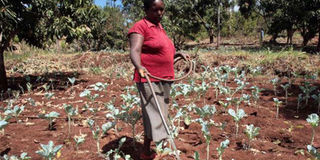Water harvesting for food security

Josephine Wanjiku waters her crop in Matanya Village, Murang'a County, on March 23, 2017. Primarily, food insecurity is a consequence of overreliance on rain-fed agriculture. PHOTO | EVANS HABIL | NATION MEDIA GROUP
What you need to know:
- One of the critical components for food security is ensuring that sufficient water is available annually for agriculture.
- The government is committed to making the country food secure by reducing reliance on rain-fed agriculture through irrigation.
During the course of the Third Medium Term Plan (MTP3) preparations, my team and I travelled across the country, and held consultations with citizens to understand their needs and priorities.
This fulfilled the constitutional provision aimed at ensuring that development planning is inclusive.
For more nuanced perspectives on ending water deficiency and guaranteeing food security, we visited various irrigation schemes in Uasin Gishu, Homa Bay, Kitui, Embu, Tharaka Nithi, Turkana, Elgeyo-Marakwet and West Pokot counties.
MAIZE SHORTAGE
Over the past few months, the country has experienced an acute maize meal shortage -- a staple meal for many Kenyans -- as a result of irregular rainfall last year.
Despite considerable progress in reducing food insecurity, the country experiences transitory food shortages annually, which are typically resolved by imports to meet the shortfall.
This is detrimental to development, and breeds other problems such as the rising importation bill, drought, and challenges in assuring national food security.
AGRICULTURE
Primarily, food insecurity is a consequence of overreliance on rain-fed agriculture, which leaves the country vulnerable due to inconsistent rain patterns, and stresses on terrestrial and aquatic ecosystems.
Unless this dependence is comprehensively addressed, through a monumental shift from rain-fed agriculture, the challenges experienced this year, and before, will continue.
The MTP3 prioritises food security and boosting agricultural production in order to guarantee availability, utilisation and access to adequate food and staples such as maize and rice to meet the nation’s needs.
One of the critical components for food security is ensuring that sufficient water is available annually for agriculture.
IRRIGATION
The MTP3 considers food security and water availability together, and recognises that water harvesting, large-scale irrigation, and enhancing water access to smallholder farmers through dams and drip irrigation are vital in reducing reliance on rain-fed farming.
The government is committed to making the country food secure by reducing reliance on rain-fed agriculture through irrigation, and has consequently achieved significant milestones.
During the MTP2 period, the government expanded the land under irrigation from 354,775 acres in 2013 to 483,670 acres this year.
The government also started various irrigation schemes, including Naipur in Turkana, Wei Wei in West Pokot, Kimira Oluch in Homa Bay, and Galana Kulalu in Tana River.
GALANA KULALU
Notably, the 4,000-acre pilot project in Galana Kulalu realised produced 39 bags per acre; and the first and second phases of the Wei Wei scheme cover more than 4,000 acres and support about 3,000 households.
Over the next five years, The MTP3 will build on this progress by completing ongoing projects, initiating new ones, and pursuing public and private sector collaborations to raise commercial agricultural production to at least 1.2 million acres.
So far, feasibility studies have been conducted for key projects currently awaiting prioritisation and budgetary allocations.
These comprise the completion of the third phase of the Wei Wei project; completion of Lake Turkwel, Murang’a and Kieni schemes; completion of 57 large-scale dams to support small-holder agricultural drip irrigation; and exploration of a potential aquifer in Turkana to utilise the substantial water reserves in the Turkana/Marsabit region.
POLICY
Alongside initiatives to provide the right foundation for water sufficiency and productivity, the third phase will also explore practical key dimensions and policy interventions to close the loop on food insecurity.
These include limiting shocks and crop failure due to diseases and pests; reducing the costs of inputs such as seeds and fertilisers; escalating local fertiliser manufacturing capacity; intensifying mechanisation; improving market access; managing post-harvest loss; and expanding strategic food reserves.
INTERVENTIONS
Additional investments to improve land and water productivity will include education and awareness on water management practices, adoption of agronomic systems, soil, crop and farm management, as well as conservation to ease the pressure on ecosystems.
These interventions will set the country on the path to food self-sufficiency, and effective structural transformation to stimulate agribusiness and agro-industrial development, boost farmer incomes, increase forest cover, curb the import bill, diversify economic activities and further secure the nation.
Mr Nyakera is the Principal Secretary of Planning & Statistics




